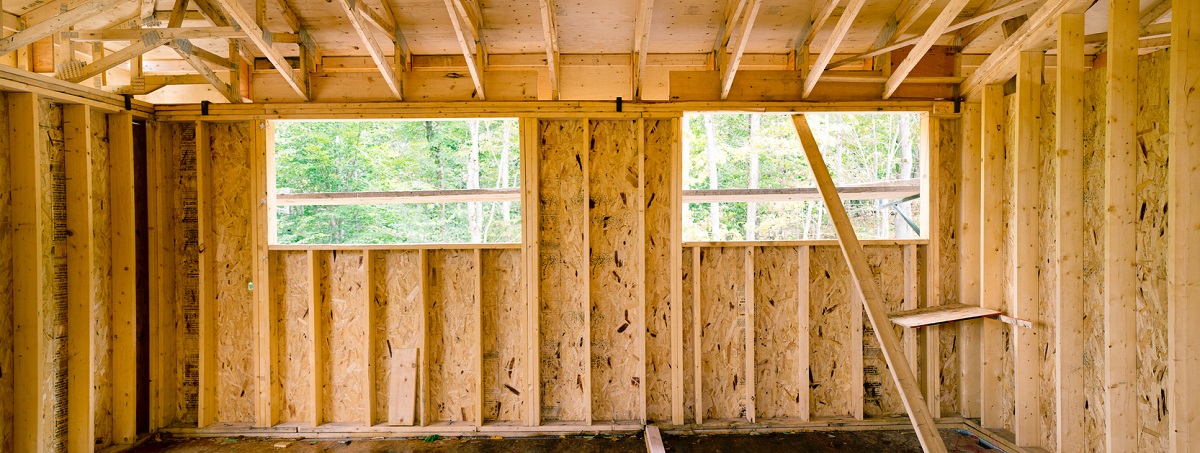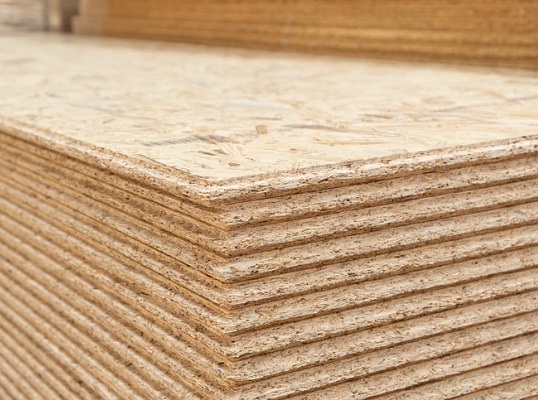What is OSB Board?
Reading time: 7 minutes
What does OSB stand for?
OSB, or Oriented Strand Board, is an engineered wood product made by layering wood strands in specific orientations. Bonded with waterproof adhesives, it creates a strong, rigid panel for construction. Widely used for flooring, wall and roof sheathing, as well as furniture, OSB's strength and cost-effectiveness make it a top choice for builders.
Advantages of OSB board
Strength and durability
One of the standout advantages of using OSB in construction is its remarkable strength and durability. OSB is engineered by compressing layers of wood strands bonded with adhesives, creating a robust and reliable material. This quality makes it an excellent choice for flooring, wall sheathing, and roofing.
Cost-effectiveness
OSB is a cost-effective alternative to traditional plywood, making it a popular choice among builders. The manufacturing process of OSB utilises smaller, fast-growing trees, which are more readily available than the larger trees required for plywood. This reduces costs and contributes to a more sustainable harvesting practice.
Sustainable
OSB's efficient use of raw materials, low waste production, potential for incorporating recycled content, and adherence to sustainable forestry practices make it a sustainable choice in the construction industry.
Moisture resistance
The moisture resistance of OSB has improved significantly over the years due to advancements in materials, manufacturing processes, and treatments. Here are some key factors that have contributed to these improvements:
-
Enhanced resin and adhesive technologies
One of the most critical developments in improving OSB's moisture resistance has been the use of advanced resin and adhesive systems. Early OSB boards often used urea-formaldehyde resins, which were susceptible to moisture and could break down when wet. Over time, manufacturers have switched to more moisture-resistant adhesives, such as phenolic resins, melamine-formaldehyde resins and isocyanate resins.
-
Improved manufacturing processes
Modern OSB manufacturing involves precise control over pressing temperatures and times, which helps to cure the adhesives more thoroughly and uniformly. This process ensures a stronger bond between wood strands, reducing the board's susceptibility to moisture ingress.
Technological advancements have allowed for better control over the orientation of wood strands, particularly in the outer layers, which are more exposed to moisture. This refinement helps in creating a more uniform and less porous surface that is less prone to water absorption.
Surface treatments and coatings
Manufacturers have also developed surface treatments and coatings to further enhance moisture resistance:
- Wax Additives: Adding waxes to the resin mix or applying wax coatings to the surface of the OSB can significantly reduce water absorption. These waxes create a hydrophobic barrier that prevents water from penetrating the board.
- Edge Sealing: Since the edges of OSB are particularly vulnerable to moisture ingress, manufacturers often apply sealants or edge coatings to provide additional protection. This practice is especially common for OSB used in roofing and flooring applications, where exposed edges are more likely.
Testing and standards compliance
The industry has also benefited from rigorous testing standards that have helped improve the quality and consistency of OSB products. Compliance with standards like the European EN standards ensures that OSB boards meet specific moisture resistance criteria, making it easier for builders to select appropriate products for their needs.
Overall, these advancements have made OSB a more versatile and reliable building material, particularly in applications where exposure to moisture is a concern.

Common applications of OSB board
Walls
OSB is a great sheet material for wall sheathing due to its strength and durability, ideal for withstanding wall stresses. Depending on the application of these boards, always make sure you have the correct grade for its purpose. We go through the different grades of OSB in more detail later on.
Floors
When it comes to flooring, OSB boards offer excellent structural integrity. They are commonly used as subflooring, providing a firm base for diverse floor coverings. The moisture-resistant properties of OSB types also help prevent warping and swelling, ensuring a long-lasting and stable floor system.
Roofs
OSB boards are frequently used in roofing applications due to their strength and stability. Furthermore, OSB's uniform composition reduces the chances of weak spots or voids, enhancing the overall strength and reliability of the roof.
Furniture
In furniture making, OSB boards are valued for their affordability and versatility. They can be easily cut to create diverse furniture, from bookcases and cabinets to tables. The even surface of OSB allows for easy painting, after sanding and sealing, making it a practical choice.
Packaging materials
OSB boards are also employed in the manufacturing of packaging materials like crates. Their robustness and resistance to impact protect goods during transportation and storage.
What are the different grades of OSB board?
OSB is manufactured in various grades, each designed for specific uses and environments. The grading of OSB is generally based on factors such as durability, moisture resistance, and structural strength. The grades are typically classified according to standards set by organisations like the European Norm (EN). Here's an overview of the common OSB grades, their manufacturing processes, and typical applications for each type:
OSB1: Non-structural, interior use
-
Manufacturing process: OSB1 is made using a lower density and standard resin binders that provide basic adhesion between wood strands. The manufacturing process does not emphasise water resistance.
-
Properties: This grade has the least resistance to moisture and is not suitable for structural applications. It's generally used in dry conditions.
-
Applications: Furniture, packaging, and interior fittings where structural strength is not required.
OSB2: Structural, interior use
-
Manufacturing process: OSB2 boards are produced using a similar process to OSB1 but with a higher density and stronger resin binders to provide better structural integrity.
-
Properties: Suitable for structural applications but only in dry conditions. It is stronger than OSB1 but still not suitable for exposure to high moisture.
-
Applications: Load-bearing applications such as flooring and interior wall sheathing in dry environments.
OSB3: Structural, exterior use
-
Manufacturing process: OSB3 is manufactured with adhesives such as phenolic resins, that enhance moisture resistance. The wood strands are oriented more precisely to ensure better load distribution.
-
Properties: This grade can be used for structural use in humid conditions, offering better moisture resistance compared to lower grade boards.
-
Applications: Roof decking, exterior wall sheathing, and subflooring, where occasional exposure to moisture might occur.
OSB4: Heavy-duty structural, exterior use
-
Manufacturing process: OSB4 undergoes a more rigorous manufacturing process, with even stronger adhesives and a denser arrangement of wood strands. This provides enhanced mechanical properties and increased moisture resistance.
-
Properties: This grade offers the highest level of strength and moisture resistance among standard OSB grades.
-
Applications: Used in demanding structural applications such as heavily loaded floors, roofs, and walls.
Manufacturing process of OSB board
As we’ve already mentioned, OSB is a highly versatile and structurally sound material widely utilised in construction.
The process begins with raw wood, typically aspen or pine, cut into strands. These strands are carefully oriented in alternate directions to enhance the structural integrity of the board. The strands undergo several stages to ensure optimal quality:
-
Drying: The wood strands are dried to a precise moisture level, ensuring they are ready for the next processing stage.
-
Blending: A blend of adhesive resins and wax is applied to the dried strands. This ensures that the strands bond effectively during compression.
-
Forming: The strands are aligned in multiple layers, each with a specific orientation. This cross-layering technique enhances the strength and rigidity of the final product.
-
Pressing: The layered strands are subjected to intense heat and pressure, causing the adhesive to cure and the wood fibres to bond. This process compresses the strands into a dense, cohesive board.
-
Trimming: The compressed boards are cooled, trimmed to size, and can have additional treatments applied at this stage.
Comparing OSB board to other engineered wood products
What is better OSB or MDF?
When it comes to choosing between OSB and MDF (Medium Density Fibreboard), it depends on your specific needs and project requirements. OSB is known for its strength and durability, making it a great choice for structural applications such as flooring, walls, and roofing. On the other hand, the MDF board is smoother and more consistent in texture, which makes it ideal for detailed mouldings and cabinetry.
Is OSB better than plywood?
Both OSB and plywood have their advantages. When deciding between OSB and plywood, consider your project's needs. OSB is cost-effective, uniform, ideal for subflooring and wall sheathing. Made by compressing wood strands with adhesives, it's strong but vulnerable to moisture damage without proper sealing, limiting use in humid or wet environments.
On the other hand, plywood is made by glueing together thin layers of wood veneer, providing better resistance to moisture and greater durability under stress. This makes plywood an excellent option for projects requiring structural integrity, such as roofing and walls. Plywood is also generally easier to cut and work with, offering more flexibility for detailed projects.
Choosing between OSB and plywood depends on budget, environmental conditions, project requirements, and personal preference.
Disclaimer: The information contained on this page is intended as an overall introduction and is not intended as specific advice from a qualified professional. Travis Perkins aims to avoid, but accepts no liability, in the case that any information stated is out of date.





